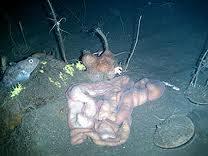Nemertea is a phylum of invertebrate animals also known as ribbon worms or proboscis worms. Although most are less than 20 centimetres (7.9 in) long, one specimen has been estimated at 54 metres (177 ft), which would make it the longest animal ever found. Most are very slim, usually only a few millimeters wide, although a few have relatively short but wide bodies. Many have patterns of yellow, orange, red and green coloration.
The foregut, stomach and intestine run a little below the midline of the body, the anus is at the tip of the tail, and the mouth is under the front. A little above the gut is the rhynchocoel, a cavity which mostly runs above the midline and ends a little short of the rear of the body. All species have a proboscis which lies in the rhynchocoel when inactive but everts (turns inside-out) to emerge just above the mouth and capture the animal's prey with poisons. A very stretchy muscle in the back of the rhynchocoel pulls the proboscis in when an attack ends. A few species with stubby bodies filter feed and have suckers at the front and back ends, with which they attach to a host.
The brain is a ring of four ganglia, masses of nerve cells, positioned round the rhynchocoel near its front end; the brains of most protostomeinvertebrates encircle the foregut. At least a pair of ventral nerve cords connect to the brain and run along the length of the body. Most nemerteans have various chemoreceptors, and on their heads some species have a number of pigment-cup ocelli, which can detect light but not form an image. Nemerteans respire through the skin. They have at least two lateral vessels which are joined at the ends to form a loop, and these and the rhynchocoel are filled with fluid. There is no heart, and the flow of fluid depends on contraction of muscles in the vessels and the body wall. To filter out soluble waste products, flame cells are embedded in the front part of the two lateral fluid vessels, and remove the wastes through a network of pipes to the outside.
All nemerteans move slowly, using their external cilia (little hairs) to glide on surfaces on a trail of slime, while larger species use muscular waves to crawl, and some swim by dorso-ventral undulations. A few live in the open ocean while the rest find or make hiding places on the bottom. About a dozen species inhabit freshwater, mainly in the tropics and subtropics, and another dozen species live on land in cool, damp places. Most nemerteans are carnivores, feeding on annelids, clams and crustaceans. A few species are scavengers, and a few species livecommensally inside the mantle cavity of molluscs. Some species have devastated commercial fishing of clams and crabs. Nemerteans have few predators. Two species are sold as fish bait.
The bodies of some species fragment readily, and even parts near the tail can grow full bodies. In most species the sexes are separate, but all the freshwater species are hermaphroditic. Nemerteans often have numerous temporary gonads (ovaries or testes), and build temporary gonoducts (ducts from which the ova or sperm are emitted), one per gonad, when the ova and sperm are ready. The eggs are generally fertilised externally. Some species shed them into the water, and others protect their eggs in various ways. The fertilized egg divides by spiral cleavageand grows by determinate development, in which the fate of a cell can usually be predicted from its predecessors in the process of division. The embryos of most taxa develop either directly to form juveniles (like the adult but smaller) or to form planuliform larvae, in which the larva's long axis is the same as the juvenile's. However, some form a pilidium larva, in which the developing juvenile has a gut which lies across the larva's body, and usually eats the remains of the larva when it emerges.
Traditional taxonomy divides the phylum in twoclasses, Anopla ("unarmed" – their probosces do not have a little dagger) with two orders, and Enopla ("armed" with a dagger) with two orders. However, it is now accepted that Anopla are polyphyletic (combine two or more separate groups), as one order is more closely related to Enopla than to the other order of Anopla. The phylum Nemertea is monophyletic (all members of the clade are descendants of one ancestor that was also a member), whose synapomorphies (distinctive features) include the rhynchocoel and eversible proboscis. Traditional taxonomy says that nemerteans are closely related to flatworms and that both are relatively "primitive" acoelomates. Now both phyla are regarded as members of the Lophotrochozoa, a very large "super-phylum" that also includesmolluscs, annelids, brachiopods, bryozoa and many other protostomes.
